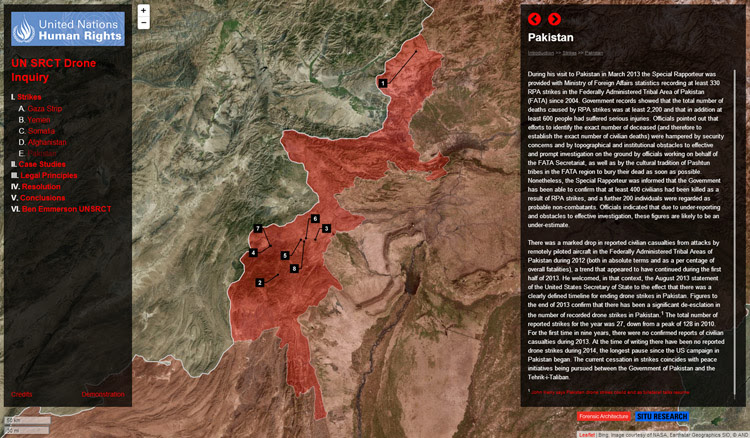Submitted by Berrin Chatzi Chousein
Forensic Architecture&SITU Research launch online platform for UN Special Rapporteur drone inquiry
Turkey Architecture News - Mar 11, 2014 - 15:42 5429 views
Today, March 11, 2014, marks the public launch of a web-based platform created by Forensic Architecture and SITU Research for United Nations Special Rapporteur on Counter Terrorism and Human Rights, Ben Emmerson. The platform provides an online presence for the Special Rapporteur's inquiry into civilian casualties from drone strikes specifically in Afghanistan, Pakistan, Yemen, Somalia and Gaza. The report, presented today to the Human Rights Council in Geneva, calls for increased government transparency and documentation of strikes when civilian casualties are known or suspected.
Forensic Architecture is based at Goldsmiths College, University of London. Goldsmiths' full press release is below:

A screenshot of the web-based platform that maps and collects information and media relevant to each of the thirty strikes the UN Special Rapporteur has highlighted for further investigation. © Forensic Architecture in collaboration with SITU Research, 2014.
Research into devastating drone strikes hampered by government secrecy, United Nations told
-Report investigates US and Israeli drone strikes
-Interactive map of 30 drone strikes produced by researchers
-Findings presented to United Nations Human Rights Council
The secrecy imposed by governments regarding drone strikes in countries such as Pakistan and Afghanistan is hampering efforts to assess the impact on civilians, researchers from the Forensic Architecture project based at Goldsmiths, University of London and SITU Research in New York have found.
The work will be presented to the United Nations Human Rights Council on 11 March as part of the final report by UN Special Rapporteur for Counter Terrorism and Human Rights, Ben Emmerson.
The final report - which includes an interactive map of drone strikes across five countries - identified numerous factors that prevent investigations. These include the fact that documentation on site is often difficult as entry points are locked down and the use of mobile phones and cameras is frequently prohibited.
The UN Special Rapporteur will present a web-based platform, produced by the Forensic Architecture team in collaboration with SITU Research, marking the location of thirty drone strikes that make up his detailed report to the UN.
Initial findings were presented in October 2013 in New York, showing that a lack of government transparency is the single greatest obstacle to evaluating the civilian impact of drone strikes.
The UN report investigates US drones strikes in Afghanistan, Pakistan, Yemen, Somalia, and Iraq; as well as Israeli strikes in Gaza, and draws on the expertise of the Forensic Architecture and SITU Research teams.
Professor Eyal Weizman, Principal Investigator on the Forensic Architecture project, said: “The forensic architecture methods we have developed are meant to generate evidence where there is little information available. Studying buildings hit by drones reveal much of the consequences of a strike. The work that we do is essential because states undertaking drone strikes, such as the US and Israel, attempt to hide their actions and even deny them outright.
“In order to hold such governments to account we need to demonstrate the devastating reality of such attacks on civilians directly hit and on entire communities living under drones.”
Since January 2013, the Forensic Architecture team has been working with Emmerson to provide architectural analysis into civilian casualties caused by drone strikes. The researchers cross referenced various types of media such as mobile phone videos, photographs, interviews, testimonies, computer models and satellite photographs to analyse the impact of drone strikes and produced a set of short videos detailing four attacks especially for this investigation.
These have been created from the perspectives of survivors and witnesses and describe the effects of these strikes on the ground, on architecture, and on the people within them. Emmerson will screen some of these videos with architectural analyses of three strikes in Pakistan and one in Gaza.
Among these is the digital reconstruction of attacks in: Datta Khel in 2011; a residential building in Mir Ali in 2010; a strike in Miranshah in 2012; and a reconstruction of an Israeli air attack that took place in Gaza. For access to these videos please see the Notes to editors.
Notes to editors:
For interviews or further information, contact
Sam Gough, Press Officer at Goldsmiths ([email protected] or +44 207 919 7970) or
Bradley Samuels of SITU Research ([email protected] or +1 718 237-5795)
-The online platform created by the Forensic Architecture in collaboration with Situ Research can be accessed here:http://unsrct-drones.com
A short demonstration video of the platform can be found here: http://vimeo.com/88203486
-The videos and stills detailing the four cases can be found here:www.forensic-architecture.org/
-Forensic Architecture is a European Research Council project based at the Centre for Research Architecture, Department of Visual Cultures, at Goldsmiths, University of London
-The research team from Forensic Architecture is as follows: Eyal Weizman (Principal Investigator); Susan Schuppli (Senior Research Fellow, Project Coordinator); Jacob Burns (Research Assistant); Steffen Kraemer (Researcher, Film Editor); Reiner Beelitz (Architectural Modelling); Francesco Sebregondi (Researcher); and Chris Cobb-Smith (Research Advisor)
-The drone strike visualisation project is being undertaken in collaboration with SITU Research, an architectural research practice based in New York City. For more information on SITU Research please visit www.situresearch.com
-The SITU Research team is as follows: McKenna Cole; Akshay Mehra; Charles-Antoine Perrault; Bradley Samuels; and Xiaowei WangThe work will be displayed at the Haus der Kulturen der Welt (House of World Cultures) in Berlin from 15 March: http://www.hkw.de/de/
> via www.situresearch.com
> via unsrct-drones.com
